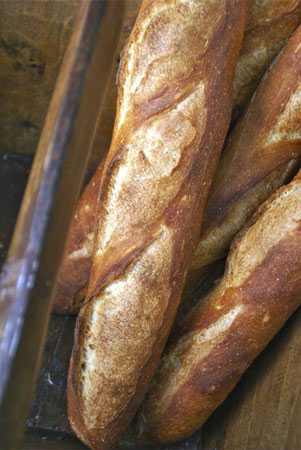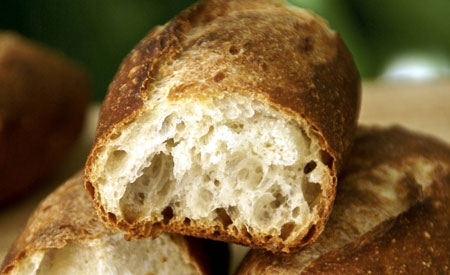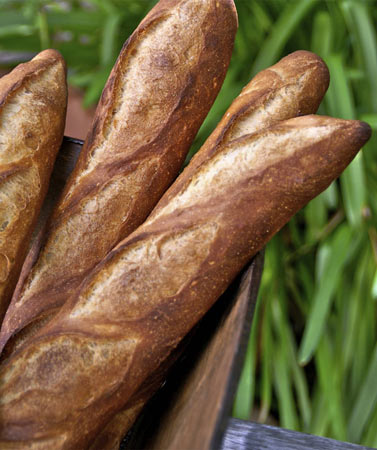
Do these baguettes look like award winners? Maybe not as I’ve made them, but their formula and execution by Sam Fromartz, author of the blog Chews Wise, recently earned Sam’s loaves the title of best baguette in Washington D.C.
With that impressive credential behind it, I wanted to see for myself how Sam’s baguettes compared to the poolish-based ones I usually bake. (I’ve never posted those on Wild Yeast, but it’s the same formula as the poolish boule I guest-posted on Baking and Books a while ago.)
Sam’s recipe contains small amounts of whole wheat flour and sourdough starter (along with some baker’s yeast), and the final dough is fermented overnight in the refrigerator. I found the resulting flavor to be less sweet and a bit more assertive than a poolish baguette, without being overtly sour. Crisp crust, light interior, definitely a winner I will keep in my repertoire!

The recipe is clearly explained on Sam’s blog, and I followed it to the letter, with one exception: I used only 1.5 teaspoons of instant yeast. (If you’re using active dry yeast, I’d advise sticking with the 2 teaspoons specified by the recipe.)
Baguettes are probably the most difficult bread for a home baker. The shaping and scoring take a lot of practice, and this particular formula yields a fairly wet dough that makes it even more challenging. However, if you’re experienced with baguettes, or if you’re not but enjoy (as I do) jumping into the deep end of the pool, go make these baguettes.
Well done, Sam, and thanks for sharing your deservedly award-winning recipe with us.

Susan,
I am still scared of making baguette, but I’ll bookmark this post. Who knows I’ll get the courage of making it sooner then I probably think, I hope!
Yours deserve to be a winner for sure!
Susan,
Thanks for showing us an awesome baguette! Sam has a great site too!
Sweet looking grigne! What about using fresh yeast? What do you suggest? And if inclined, could it work as just a sourdough baguette?
Oh, someday I will make baguettes. These look great.
Baguette’s have been on my standard list for some time, but not fermented in the fridge! I look forward to trying then, thanks!
They look great. You cooked them long enough to get the carmelized exterior – and the interior looks nice too. I should try your poolish and post on that over at ChewsWise.
Jeremy, for fresh yeast I’d use about 2/3 of a cake, but I don’t expect it would change the flavor. As for 100% sourdough, sure you can shape sourdough into a baguette shape, but as for that thin crisp shattery crust and characteristic wheat flavor, well, I’m going to have to agree with M. Suas (http://www.stirthepots.com/2009/03/michel-suas.html, 22:00) on this one (i.e. no 🙂 )
Sam, I’d love to see what you do with the poolish baguette and how you like it.
Hi, Susan.
Those are lovely baguettes!
Sam’s method is almost identical to the one I use, which is derived from Anis Bouabsa’s baguettes which won the “Best Baguettes in Paris” award in 2008. (Janedo, of http://www.aulevain.canalblog.com/, suggested adding the starter to Anis’ straight dough method.) The cold retardation of the dough does enhance the flavor. It also results in a very relaxed, extensible dough.
If I read Sam’s recipe correctly, he sometimes retards the dough in bulk and then also retards the formed loaves. Have you ever tried this double retardation?
David
They look just amazing, Susan!! Award-winning for sure! I’ve simply got to try this recipe. Thanks for the link.
These look absolutely wonderfult. My dad still bakes bread to this day at 82, no store bought ever. I am going to share this with him.Thanks!
I have yet to try baguettes, these really look amazing!
I knew you were going to say that!!! 😉
These baguettes look lovely, Susan! I can’t wait to try the recipe when I come back from my trip.
Susan! These are amazing!!! I mean, they look just like the ones we see at the boulangerie – bravo!
David, there is just a bulk retardation, which is the common method for the baguette tradition. I do not retard the loaves again after shaping. Just a 45-60 minute second rise after shaping and then into the oven. I explain in the essay linked to the recipe why I also added a bit of sourdough.
Gorgeous Susan… but would we expect less? No!
Congrats to Sam as well. I don’t put that much yeast in though. Too much for me and with our French flour.
An overnight cold retarding of the dough is not French tradition. Anis was criticized for his unorthadox baguette recipe. NOT tradition! And the French love their traditions.
Lovely baguette. Perfect for a Sunday breakfast in summer.
Ooh. I can’t wait to get my sourdough starter going. I usually bake with poolish, but you make these sound so delicious. I’ll have to try them!
Those look amazing. And I actually live near DC, so I will have to hunt them down and give them a try!
Hi, Sam.
I re-read your recipe and your blog entry on how it evolved. I see that what you talked about retarding for another period was leftover dough, not formed loaves.
Jane’s point about what the French regard as “traditional” is interesting. First, cold retardation is hardly “traditional,” but it may be in another generation. What’s amusing is that introducing levain is also not “traditional.” Ahhh … but, you might say, all french bread was raised with wild yeast until the historically recent introduction of commercial yeast (1880’s?). But then, for heaven’s sake, the baguette itself is an even more recent “innovation!”
Thus, my new definition of “traditional:” What was prevalent in your grandparent’s youth. Anything older is … something else.
David
P.S. Susan: If this is out of place on your blog, just tell me to take it private or something.
I found several bakers that relied on an overnight bulk retard in Paris – it was the central element of the ‘baguette renaissance’ at boulangerie Delmontel, which won best baguette in 2007. But others relied on it too. It is not the method of the usual baguette, which can be mixed and baked in as little as a couple of hours but is a method for the “baguette tradition” — more expensive and better than the everyday baguettes. Eric Kayser also does a 8-20 hour refrigerated proofing but after the loaves are shaped.
Your baguettes are definitely award deserving, Susan. Someday I’ll make baguettes like these. 🙂
Damn! Another motivational challenge, but one can only eat so much bread! I guess I could just give it away.
I think something very strange is happening to me as a baker – once, my only real goal in baking was to enjoy the taste of my creations – but recently, my ultimate satisfaction is shifting more to how the dough moved through the stages of development, how well it proofed, how it sprang in the oven, how it looks after baking, how crispy/chewy the crust is, and what kind of crumb is has.
Am I unique? Or is this simply a baker’s transition?
They look great! I could just gnaw one up right now, no butter or toppings needed. 🙂
I was just given one of those baguette pans shaped like a double trough. Looks like that goes in the Goodwill bag labeled bourgeoisie bric-a-brac.
I’m going to try it your way.
Denise
http://digginginthedriftless.wordpress.com/
These remind of the baguettes in France~ I can totally imagine having a buttered chunk of this and dunking it into hot chocolate… I’ll be tackling baguette in a couple months with the BBA, and can only hope mine turn out as lovely as yours!
Hi Susan!
I’m writing to you from Sydney Australia. For about a year now I’ve been sneaking into your BLOG and reading posts, looking at photos, stealing recipes and ideas and basically enjoying your site. I’m currently studying baking here in Sydney and must tell you that you have more love for the craft, knowledge and most of all, skill than most people who work in the industry. Thanks so much for your generosity and for taking the time (of which there is never a lot of) to share your knowledge and thoughts with others!
Hi Susan,
I am surely way out of my league here, but I am willing to give this recipe a try. However, I am not sure I know what “90 grams sourdough starter, 100-percent hydration, made with equal parts of water and flour by weight, fermented for 7 to 10 hours” means. Is this just a regular starter? How do you ferment a starter from 7 to 10 hours?
If this means “mix 45g of flour with 45g of water, let stand in room temperature for 7 to 10 hours,” is this enough time to get some fermentation started?
Thanks a lot for the great blog.
Susan,
Like you, I enjoy a challenge. However, unlike you, my jumping in the deep end didn’t turn out so well. My attempt today resulted in what can only be called “mutant flatbreads,” as Sam describes on his site. But even though the appearance was dreadful, the taste was tremendous. For me working with a dough this slack was not easy. And that just goes to prove what everyone who reads your blog knows: you have a special talent.
Melissa, Sam’s recipe assumes that you have a mature sourdough starter going (for one way to do this, here is my post about it: http://www.wildyeastblog.com/2007/07/13/raising-a-starter/). The starter is “fed” regularly, so the 7–10 hours Sam refers to means that you use the starter in the bread 7–10 hours after feeding it.
I have made this twice, and it replaces my prior favorite which was the baguette with overnight ferment from SFBI. The additional features I like on this are (1) 2% whole wheat flour. The small amount of ash in WWF helps. (2) Three folds before bulk ferment. Baguette needs strong gluten to get good volume. (3) Cold ferment. Much easier to shape cold dough than room temp dough. (4) 250 gm size. Fits the width of 18 inch 1/2 sheet pan. I proof on linen that is 18 inches wide and make 8 at at time on two stones–one on bottom rack and one on middle rack. (5) Four cuts instead of the traditional odd number of 3 or 5. Length of cut seems right. (6) Small amount of liquid levain increases the gluten strength and improves the cuts. Solveig Tofte used this in her 2008 baguette. (7) Not included in the formula, but I do not find steam helps in a home oven that has vents and fans. I lightly mist bread and cover with a sheet of parchment that has been sprayed with pan release. I take the parchment off after 5 minutes. I get good volume and cuts open well. (8) Storage. I freeze as soon as cool and reheat by misting the bread with water and reheating at 350F for 3 minutes, then resting bread an additional 3 minutes. (9) Shaping. Baguette is okay, but I prefer squares of 400 gm with same dough.
These are all such great comments on the continuing life of this recipe!
For those interested in my experience baking at a Paris boulangerie (which helped in my own development that led to this recipe) check out the article in the August 2009 premier issue of AFAR magazine. On the news stands or check out the PDF at my blog:
http://www.chewswise.com/chews/2009/09/baguette-paris-afar-story.html
This is a fantastic recipe Sam, the flavour development with the cold ferment was exceptional. I can’t wait to make it again!
I did find that with 2tsp of instant yeast there was an almost volcanic reaction from the dough (it being mid-summer here in South Africa), which continued overnight in the fridge . I had considered lowering the amount of instant yeast in the recipe, and then I noticed that Sam had commented below the recipe on his blog that he uses only 1 tsp in Summer. I will definitely scale back the instant yeast next time.
Thanks Susan for mainting this wonderful blog of yours. Long may it continue!
If you are using a wild yeast starter (levain) then why are you using dry yeast?
I may have misunderstood by your blog title that you were using a wild yeast starter. I do not want to use commercial yeast and for the life of me I am having trouble figuring out the terminology I guess. I have my wild yeast starter. Is this the levain or do I make a levain from this? Confusing to me, as I thought the levain was the starter. If I want to make a French baguette from wild yeast starter to I dissolve the starter in water, add flour etc , knead, proof , bake etc sort of in that order?